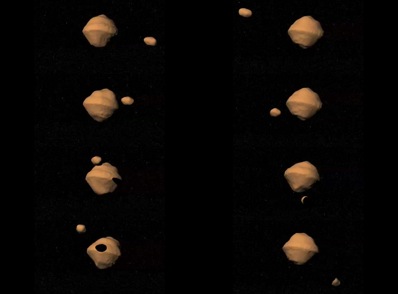
Fast spinning asteroids spawn new generation
DR EMILY BALDWIN
ASTRONOMY NOW
Posted: 26 August 2010


New observations conducted with the one-metre telescope at the Wise Observatory in Israel and the Danish 1.54-metre telescope at La Silla, Chile, conclude that fast spinning asteroids can split to spawn asteroid pairs.
Binary asteroids are fairly common in the Solar System, but their formation mechanism has long been speculated. Now, thanks to new research led by Petr Pravec of the Astronomical Institute in the Czech Republic, the connection has been made between asteroid pairs and a process by which an increased spin leads to part of the larger body flinging off a second, 'baby' asteroid.

A new study indicates that some binary asteroids, like the pair depicted in orbit around each other in this visualization, have the ability to escape from each other shortly after they are formed. Image: JPL/NASA.
The spin up is likely provided by the YORP effect (short for Yarkovsky–O’Keefe–Radzievskii–Paddack, after its proponents); sunlight incident on an asteroid warms it up and the escaping radiation imparts a small change in energy to the asteroid, altering its rotation rate. "An asteroid with a diameter of a few kilometres is estimated to be spun up to the critical spin rate by the YORP effect in a time on the order of a few tens of million years," explains Pravec, who tells Astronomy Now that for a range of estimated asteroid bulk densities, the critical period of rotation required to cause the splitting effect lies between 2.1 hours and four hours.
“Sunlight striking an asteroid less than 10 kilometres across can change its rotation over millions of years, a slow motion version of how a windmill reacts to the wind,” says co-author Daniel Scheeres. “This causes the smaller asteroid to rotate more rapidly until it can undergo rotational fission. It’s not hard for these asteroid pairs to be pushed over the edge.”
When the binary system first forms the orbits are initially chaotic – the smaller one 'steals' rotational energy from the larger one – the net result being that the bigger asteroid rotates more slowly and the size of the orbit begins to increase. In some cases the asteroids escape from each other's gravitational clasp, but for this to occur the smaller asteroid is always less than 60 percent the size of its companion.
The asteroids in the study ranged from about one kilometre to about ten kilometres, and the mass ratios and spin rates inferred from measuring the relative brightness of each pair match predicted characteristics for binary asteroids. “It was clear to us then that just computing orbits of the paired asteroids was not sufficient to understand their origin,” says Pravec. “We had to study the properties of the bodies. We used photometric techniques that allowed us to determine their rotation rates and study their relative sizes.”
Pravec tells Astronomy Now that their sample currently contains 84 identified asteroid pairs, but that it is ever-growing as more asteroids are discovered by asteroid surveys and their orbits are refined with new measurements of their positions. He notes, "one particularly interesting thing that is emerging most recently is that some larger members of the pairs have a bound satellite. We are going to study them thoroughly to find out how rare or common such "triple" systems are, whether the third body may be another generation in the continuing fission process, or what additional mechanism operated there in formation of such complex systems."
He also adds that this fission process only applies to small, irregular bodies, since large bodies with shapes close to a sphere are not significantly affected by the YORP effect. Fission was one of the early, since discarded, theories for the formation of the Earth's Moon, which described the Earth 'spinning-off' the Moon; it is now widely accepted that it was created when a Mars-sized object collided with the early Earth.
Pravec and his team's work is published in this week's edition of the journal Nature.
|



